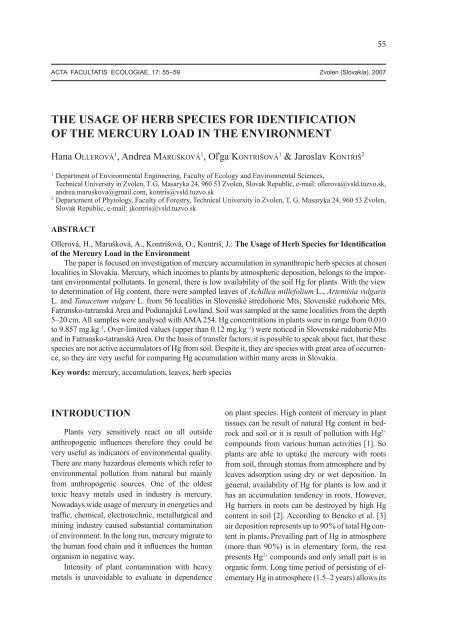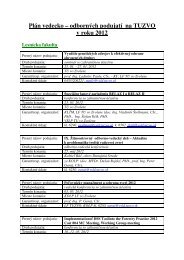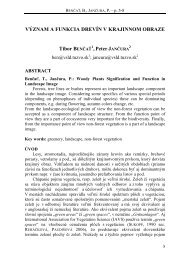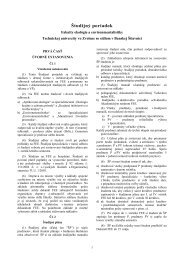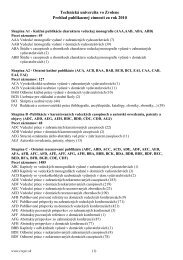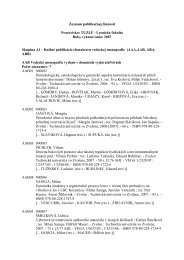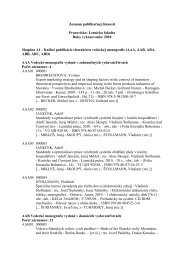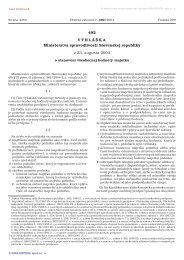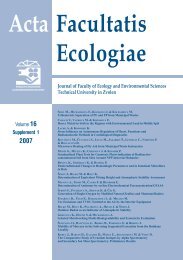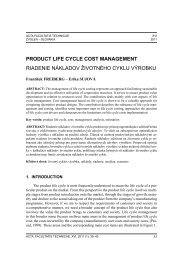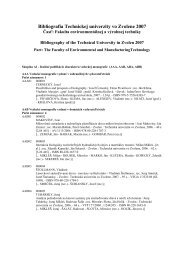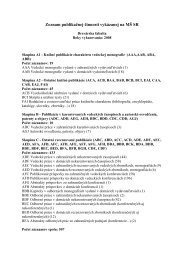Acta Facultatis Ecologiae - Technická univerzita vo Zvolene
Acta Facultatis Ecologiae - Technická univerzita vo Zvolene
Acta Facultatis Ecologiae - Technická univerzita vo Zvolene
Create successful ePaper yourself
Turn your PDF publications into a flip-book with our unique Google optimized e-Paper software.
55<br />
ACTA FACULTATIS ECOLOGIAE, 17: 55– 59 Z<strong>vo</strong>len (Slovakia), 2007<br />
THE USAGE OF HERB SPECIES FOR IDENTIFICATION<br />
OF THE MERCURY LOAD IN THE ENVIRONMENT<br />
Hana OLLEROVÁ 1 , Andrea MARUŠKOVÁ 1 , Oľga KONTRIŠOVÁ 1 & Jaroslav KONTRIŠ 2<br />
1<br />
Department of Environmental Enginnering, Faculty of Ecology and Environmental Sciences,<br />
Technical University in Z<strong>vo</strong>len, T. G. Masaryka 24, 960 53 Z<strong>vo</strong>len, Slovak Republic, e-mail: ollerova@vsld.tuz<strong>vo</strong>.sk,<br />
andrea.maruskova@gmail.com, kontris@vsld.tuz<strong>vo</strong>.sk<br />
2<br />
Departement of Phytology, Faculty of Forestry, Technical University in Z<strong>vo</strong>len, T. G. Masaryka 24, 960 53 Z<strong>vo</strong>len,<br />
Slovak Republic, e-mail: jkontris@vsld.tuz<strong>vo</strong>.sk<br />
ABSTRACT<br />
Ollerová, H., Marušková, A., Kontrišová, O., Kontriš, J.: The Usage of Herb Species for Identification<br />
of the Mercury Load in the Environment<br />
The paper is focused on investigation of mercury accumulation in synanthropic herb species at chosen<br />
localities in Slovakia. Mercury, which incomes to plants by atmospheric deposition, belongs to the important<br />
environmental pollutants. In general, there is low availability of the soil Hg for plants. With the view<br />
to determination of Hg content, there were sampled leaves of Achillea millefolium L., Artemisia vulgaris<br />
L. and Tanacetum vulgare L. from 56 localities in Slovenské stredohorie Mts, Slovenské rudohorie Mts,<br />
Fatransko-tatranská Area and Podunajská Lowland. Soil was sampled at the same localities from the depth<br />
5–20 cm. All samples were analysed with AMA 254. Hg concentrations in plants were in range from 0.010<br />
to 9.857 mg.kg –1 . Over-limited values (upper than 0.12 mg.kg –1 ) were noticed in Slovenské rudohorie Mts<br />
and in Fatransko-tatranská Area. On the basis of transfer factors, it is possible to speak about fact, that these<br />
species are not active accumulators of Hg from soil. Despite it, they are species with great area of occurrence,<br />
so they are very useful for comparing Hg accumulation within many areas in Slovakia.<br />
Key words: mercury, accumulation, leaves, herb species<br />
INTRODUCTION<br />
Plants very sensitively react on all outside<br />
anthropogenic influences therefore they could be<br />
very useful as indicators of environmental quality.<br />
There are many hazardous elements which refer to<br />
environmental pollution from natural but mainly<br />
from anthropogenic sources. One of the oldest<br />
toxic heavy metals used in industry is mercury.<br />
Nowadays wide usage of mercury in energetics and<br />
traffic, chemical, electrotechnic, metallurgical and<br />
mining industry caused substantial contamination<br />
of environment. In the long run, mercury migrate to<br />
the human food chain and it influences the human<br />
organism in negative way.<br />
Intensity of plant contamination with heavy<br />
metals is una<strong>vo</strong>idable to evaluate in dependence<br />
on plant species. High content of mercury in plant<br />
tissues can be result of natural Hg content in bedrock<br />
and soil or it is result of pollution with Hg 2+<br />
compounds from various human activities [1]. So<br />
plants are able to uptake the mercury with roots<br />
from soil, through stomas from atmosphere and by<br />
leaves adsorption using dry or wet deposition. In<br />
general, availability of Hg for plants is low and it<br />
has an accumulation tendency in roots. However,<br />
Hg barriers in roots can be destroyed by high Hg<br />
content in soil [2]. According to Bencko et al. [3]<br />
air deposition represents up to 90 % of total Hg content<br />
in plants. Prevailing part of Hg in atmosphere<br />
(more than 90 %) is in elementary form, the rest<br />
presents Hg 2+ compounds and only small part is in<br />
organic form. Long time period of persisting of elementary<br />
Hg in atmosphere (1.5–2 years) allows its


